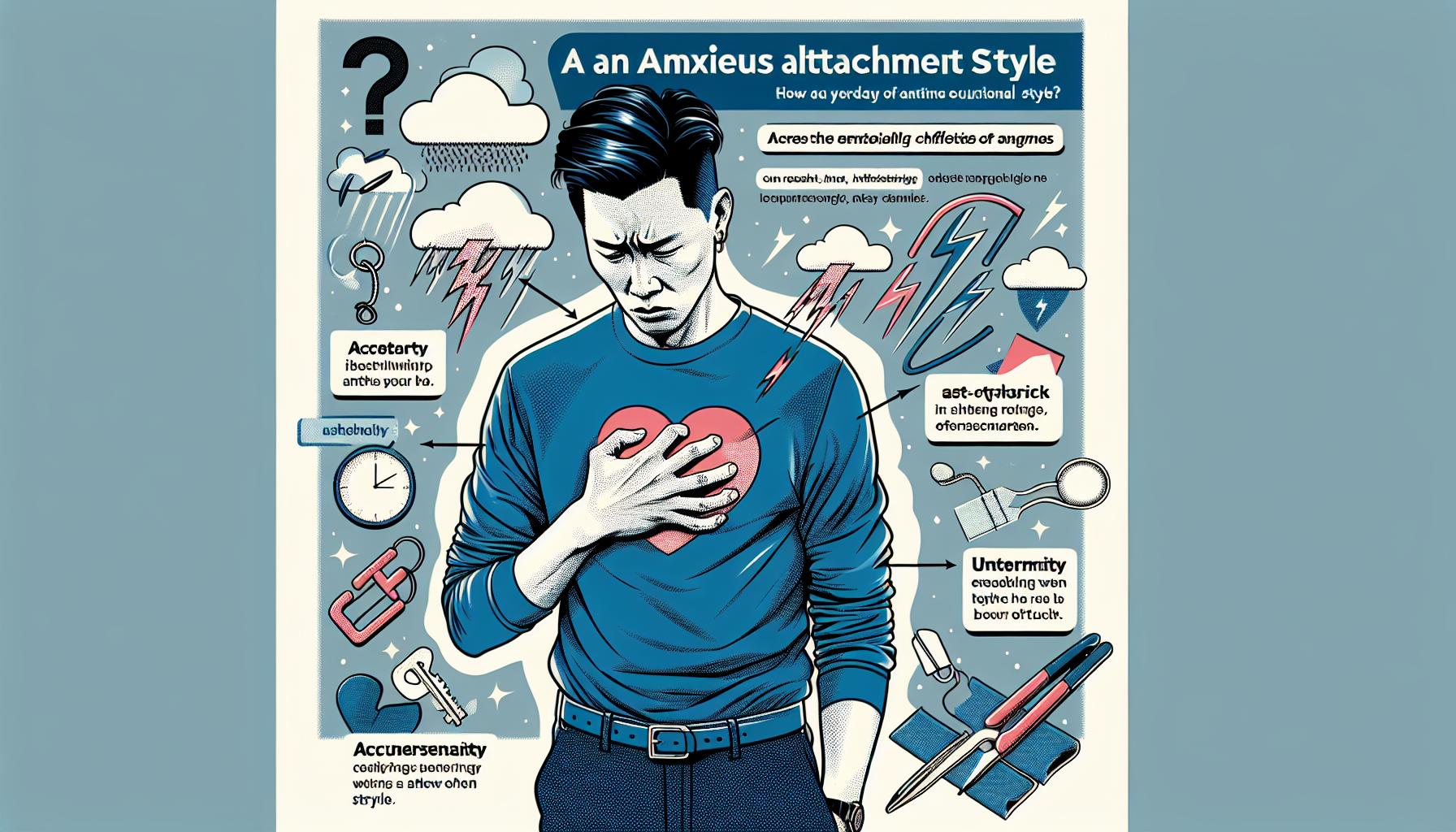Navigating relationships can be tricky, especially when you’re grappling with an anxious attachment style. It’s like being on a roller coaster of emotions, with your mind constantly buzzing with questions about your partner’s commitment and love for you. But don’t worry, it’s not a life sentence.
Understanding and addressing your anxious attachment style is the first step towards healthier relationships. You can learn to manage your anxiety, build self-esteem, and foster secure attachments. This article is your guide to unraveling the complexities of anxious attachment and finding your way towards a more balanced emotional life.
Remember, it’s not about changing who you are, but about understanding and working with your unique emotional blueprint. Stick around, and you’ll discover practical strategies to cure your anxious attachment style.
Key Takeaways
- Anxious attachment style is a pattern of behavior rooted in insecurity, characterized by a fear of rejection, a need for constant validation, and emotional highs and lows dictated by the state of one’s relationships.
- This type of attachment can have a profound influence on all types of relationships, causing strain, tension, and emotional exhaustion for both the individual and their partner. It can also lead to self-neglect and hinder personal growth.
- Recognizing and understanding one’s anxious attachment style is the crucial first step towards change, with self-care practices, self-esteem improvement, fostering independent thinking, and mindfulness forming the core strategies for managing it.
- Professional help, such as cognitive behavior therapy, can be highly beneficial in modifying attachment style-related issues, providing important tools for developing healthy coping mechanisms and changing unhelpful thought patterns.
- Building secure attachments that foster trust, mutual respect, and emotional stability involves consistent effort and open communication. Mindfulness exercises and patience are critical to this process.
- While progress may be slow, moving from an anxious to a secure attachment style promises healthier, more fulfilling relationships, an enhanced sense of self, and a better quality of life.
Understanding Anxious Attachment Style

Anxious attachment style is a term psychologists use to describe a specific pattern of behavior rooted in insecurity. It’s a challenging emotional landscape, often feeling like a roller coaster. You’ve likely experienced this first hand where one minute, you’re up in the clouds, feeling loved and secure. The very next moment, you’re plummeting downwards, engulfed by uncertainty and focusing on any sign that points to rejection or abandonment.
Anxious attachment style is one of the four primary categories described in Attachment Theory. It emphasizes the role of early relationships in shaping how you interact with others as an adult. The importance of attachment styles cannot be overstated. If you can relate to anxious attachment patterns, it’s crucial to remember that these behaviors are not your fault and that change is possible.
You’ll often find people with an anxious attachment style are hypersensitive to the slightest shifts in their partner’s mood or behavior. This perception stems from an internal fear of losing their loved ones. This fear leads to a vicious cycle of anxious thoughts and actions that can inadvertently drive the people you wish to keep close, further away. It’s tragic but crucial to understand how this fear navigates relationships to start rectifying it.
Managing this attachment style involves recognizing and challenging your negative thought patterns, building better communication skills, and fostering self-esteem. By identifying the root causes of your anxiety, you can begin to reshape your emotional blueprint and promote secure attachments in your relationships.
Thus, understanding your anxious attachment style is not as daunting as it appears on the surface. The first step is always acknowledgment. Recognize the signs but remember that it’s not a life sentence. You’ve got the power to alter these behaviors and foster healthy relationships. It’s challenging, but it’s entirely within your reach.
While we’ve covered how an anxious attachment style looks, the next section will discuss the practical strategies to overcome this attachment style. Implementing these suggestions and practices might not change your problematic patterns overnight. However, it’s through understanding that growth begins to happen.
Signs and Symptoms of Anxious Attachment

As you traverse your journey towards healthier relationships, it becomes imperative to understand what an anxious attachment style looks like. As a matter of fact, knowing the symptoms equips you better in dealing with it.
Anxious attachment often manifests in an intense fear of being abandoned. You’re likely always on edge, imagining the worst possible outcomes in your relationships. This fear can lead to a tendency to be overly dependent on your partner, displaying a clingy behavior.
You may also find yourself constantly seeking validation and reassurance from your partner. This stems out of a lack of self-confidence and a skewed self-image. It’s not uncommon for individuals with an anxious attachment style to feel unworthy, undervalued, or not good enough.
Another telltale sign is the hypersensitivity to your partner’s actions and words. You might have a habit of overanalyzing and reading too much into situations. Even the slightest hint of disapproval or disagreement might trigger feelings of anxiety or distress.
Finally, emotional highs and lows become the norm. When things are going well in your relationship, you might feel on top of the world. But then, any sign of trouble or disagreement can send you spiraling into a pit of anxiety and worry.
It’s essential to remember that an anxious attachment style is not a life sentence, but just a learned behavior that can be unlearned with time, effort and correct strategies. The key to overcoming an anxious attachment style lies in acknowledging and recognizing these signs and symptoms.
In the next section, we will delve deeper into the practical steps and strategies that can assist in overcoming an anxious attachment style.
Impact of Anxious Attachment on Relationships
Anxious attachment style can have a profound impact on your relationships, personal life, and overall wellbeing. Remember, awareness is the first step towards resolving these issues. It is important to shed light on the many potential challenges that stem from this pattern of attachment.
A primary concern is the strain an anxious attachment style can put on your romantic relationships. With feelings of insecurity and the pressing need for reassurance, you’re likely to place an unhealthy emphasis on your partner’s attention and affection. This often translates into a series of high and low emotions. When the affection is high, you feel great. However, when it’s low, you plunge into an abyss of panic and anxiety, fearing abandonment.
Furthermore, the flip-flopping of emotions can lead to emotional exhaustion, not just for you but for your partner as well. Over time, this increasing emotional demand can result in a constant state of tension and discontent.
Likewise, the anxious attachment style can affect your platonic relationships too. The fear of rejection may hold you back from initiating friendships, causing you to settle for relationships that are less than fulfilling. You might also find yourself exhausting your friends with your constant need for validation.
Moreover, you might overlook your own needs to keep others close, thus neglecting your own self-care and losing sight of personal growth.
Having unveiled the potential problems anxious attachment can create, you mustn’t lose hope. You’ve come this far in understanding the impact of this attachment style—it is absolutely possible to make the necessary changes with the proper steps and guidance. Yes, it may seem difficult at first but remember, substantial progress is gradual and takes time.
Strategies to Manage Anxious Attachment
Anxious attachment can be a formidable issue to tackle, but it’s not impossible to overcome. It’s time to uncover the strategies that allow for a healthier approach to relationships.
As the saying goes, “Knowing is half the battle.” Understand your attachment style. Recognition is a pivotal step towards change. Identifying and accepting your anxious attachment are keys to addressing this issue head on.
Engaging in self-care practices stacks up as vital. They can help you develop a healthier relationship with yourself. These can range from setting boundaries, prioritizing your needs to indulging in activities that bring you joy.
Another strategy involves working on improving your self-esteem. Individuals with anxious attachment often wrestle with feelings of inadequacy or insecurity. By focusing on your strengths and accomplishments, you can start to shift the negative narrative.
It’s also essential to foster independent thinking and resilience. This allows you to have a distinct identity outside your relationships, thereby reducing dependency.
Practice mindfulness – focus on the present moment and work on accepting things as they are. Mindfulness-based techniques can help reduce anxiety levels and provide a clearer perspective.
Remember, professional help is beneficial. A competent therapist can deliver cognitive behavior therapy which is often successful in modifying attachment style related issues. They can guide you towards developing healthy coping mechanisms and changing unhelpful thought patterns.
With consistency and patience, these strategies can pave the way towards transforming anxious attachment style into a more secure one. The journey may not be easy, but it’s worth it. For, it leads you to an enhanced version of yourself and healthier, more fulfilling relationships.
Though you can adopt these strategies independently, remember, you don’t have to weather the storm alone. Involve trusted friends or family and keep open lines of communication. Engage in a support system that understands and supports your path towards change.
Building Secure Attachments

Armed with knowledge and a robust strategy to manage your anxious attachment style, you’re ready to move onto the next stage. It’s time to explore creating secure attachments, a healthier approach that cultivates trust, mutual respect, and emotional stability.
Secure attachments aren’t established overnight. Just as it took time to understand and come to terms with your previous attachment style, it’s going to require effort and consistency to build new, healthier connections. However, the reward – a sense of security, peace, and fulfillment – makes every bit of the effort worth it.
Start small. Create space for relationships that inspire a feeling of safety and acceptance. Surround yourself with people who are considerate, responsive, and reliable.
Communicate openly with your loved ones. Share your feelings honestly, even when it feels uncomfortable. This aspect of vulnerability encourages constructive conversation and aids in calming down anxious feelings.
Take up mindfulness exercises and focus on staying grounded in the present. Often, anxious attachment style is a product of overthinking or dwelling too much on what could go wrong. Mindfulness, by keeping you anchored in the present, helps control such negative thought spirals.
One essential component in the healing process is patience. You might not see results immediately, but it’s crucial not to get disheartened or revert to old habits. Slowly but surely, with continual and consistent work, secure attachment will become more natural.
Making use of professional resources is a worthwhile decision. Therapists offer invaluable insights, propose effective coping mechanisms, and provide support throughout your journey to secure attachment. They may suggest techniques such as Cognitive Behavioral Therapy (CBT) or Eye Movement Desensitization and Reprocessing (EMDR), known to be instrumental in treating attachment-based anxieties.
Remember that building secure attachments is a journey, one that is challenging yet rewarding. Your progress might sometimes appear slow, but each step forward brings you closer to achieving emotional equilibrium, healthy relationships, and an overall better quality of life.
Conclusion
You’ve taken a deep dive into curing anxious attachment style. Remember, it’s a journey, not a destination. Building secure attachments is a gradual process, it’s about fostering trust, respect, and emotional stability. Surrounding yourself with supportive individuals, practicing open communication, mindfulness, and patience are key. Don’t shy away from seeking professional help such as therapy using CBT or EMDR. These techniques can provide sustained progress towards secure attachments and an improved quality of life. Keep moving forward, because you’re worth it. This process isn’t easy, but it’s definitely worth the effort. You’re on the right path to healthier, more secure attachments.
Frequently Asked Questions
What is the main theme of the article?
The article primarily discusses the journey from managing a state of anxious attachment to building secure attachments in relationships. This includes forming healthier ties based on mutual respect, emotional stability, and trust.
What are the key steps discussed for building secure attachments?
The key steps to build secure attachments include surrounding oneself with supportive people, practicing clear and open communication, mindfulness, and patience.
What is the role of professional help in this transition?
The article recommends seeking professional assistance, such as therapy. Techniques like Cognitive Behavioral Therapy (CBT) or Eye Movement Desensitization and Reprocessing (EMDR) can be invaluable tools for making long-term progress towards secure attachments and enhancing the quality of life.
How important is the concept of trust in building secure attachments?
Trust is fundamental in building secure attachments. The article underscores the necessity for trust which serves as the backbone for forming healthier and secure relationship bonds.
How does mindfulness contribute to secure attachments?
Mindfulness contributes to secure attachments by helping individuals understand their feelings and reactions better. This newfound awareness can aid in forming healthier habits and relationships.
The post Mastering Secure Bonds: A Guide to Cure Anxious Attachment Style appeared first on After Anxiety.
Mastering Secure Bonds: A Guide to Cure Anxious Attachment Style published first on https://after-anxiety.com/

